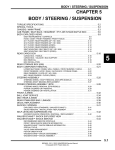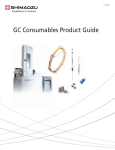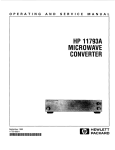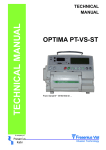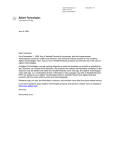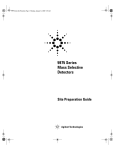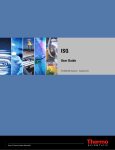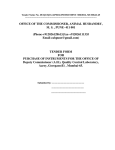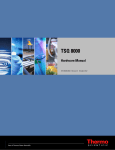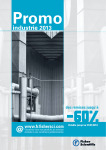Download GC Columns and Accessories >>
Transcript
Item 1 2 3 4 Description Adapter for capillary column (Kit) Retaining nut for 6mm OD metal column and ferrule Brass front/back ferrule for 1/8in. OD metal column Retaining nut for 1/8in. OD column and ferrule Cat. No. 34709542 Quantity 1 35020117 1 29004666 1 35003062 1 Nitrogen Phosphorus Detector (NPD), TRACE GC Ultra Description NPD collecting electrode Ceramic insulator Collecting electrode pin Retaining screw TS-2 source (standard) TS-1 source for ENS mode NPD jet NPD (deactivated silcosteel) jet Jet removing tool Cat. No. 25901110 30202310 20601602 31106008 46500255 46500250 40404302 40404303 20501900 Quantity 1 1 1 1 1 1 1 1 1 Thermal Conductivity Detector (TCD), TRACE GC Ultra and FOCUS GC GC Instrument Spare Parts Item 1 2 3 4 5 5 6 6 7 Electron Capture Detector (ECD), TRACE GC Ultra Item 1 2 3 4 5 6 7 8 Description Upper seal, aluminum ECD collecting electrode ECD fixing tool Lower seal, silver ECD blocking nut Adapter for stack configuration Heating block for stacked configuration (including heater and RTD) Cover for heating block Cat. No. 29032608 27700350 20502150 29015058 35001120 34709007 Quantity 10 1 1 2 1 1 35425064 1 24104449 1 GC Columns and Accessories >> Thermal Conductivity Detector (TCD), TRACE GC Ultra and FOCUS GC Nitrogen Phosphorus Detector (NPD), TRACE GC Ultra Electron Capture Detector (ECD), TRACE GC Ultra www.thermoscientific.com/chromatography 3-145 GC Columns and Accessories Flame Photometric Detector (FPD), TRACE GC Ultra Item 1 2A 2B 2C 2D 2E 3 4 5 5 6 7 7 7 8 9 10 11 Description Mirror plug Graphite seal Heat shield Viton® O-ring Viton® O-ring Viton® O-ring Detector body Aluminium O-ring FPD jet FPD (deactivated Silcosteel) jet Flange and relevant Viton® O-ring Interferential filter for sulphur Interferential filter for tin Interferential filter for phosphorus Photomultiplier Heater/sensor/coil cable FPD fixing tool FPD blocking nut Cat. No. 35005350 19004589 (*) 19004589 (*) 19004589 (*) 19004589 (*) 19004589 (*) 19050111 29032630 40404511 40404512 36814235 28107000 28107001 28107100 28600450 23043479 20502150 35001125 Quantity 1 2 2 1 1 1 1 10 1 1 1 1 1 1 1 1 1 1 Flame Photometric Detector (FPD), TRACE GC Ultra * Maintenance kit for FPD Detector Base Body, TRACE GC Ultra and FOCUS GC Item 1 2 3 4 5 6 7 8 Description Adapter for flow measurement Brass blind cap Silicon seal Blind jet Seal, silver Adapter for capillary column Graphite ferrule Fixing nut for column Cat. No. 35004107 35006101 29033037 40401900 29037100 34725436 See page 3-091 35032423 Quantity 1 1 10 2 10 2 Detector Base Body, TRACE GC Ultra and FOCUS GC 5 Thermo Scientific Chromatography Columns and Consumables 2012-2013 UltraFast Module Option – UFM S/SL-FID Configuration, TRACE GC Ultra 3-146 Item 1 2 3 4 5 6 7 Description Silver seal for injector base Terminal fitting for capillary column 1/4in. retaining nut for injector base Silver seal for detector base Terminal fitting for detector base M8 x 1 retaining nut for detector base Threaded locking ring Cat. No. 29033629 34705458 35002132 29037100 34705456 35002134 35001468 Quantity 10 1 1 10 1 1 1 UltraFast Module Option – UFM PTV-FID Configuration, TRACE GC Ultra Item 1 2 3 4 5 Description Injector guide Silver seal for detector base Terminal fitting for detector base M8 x 1 PTV retaining nut for detector base Supporting disk Cat. No. 24104482 29037100 34705457 35002130 36812760 Quantity 1 10 1 1 1 UltraFast Module Option – UFM S/SL-FID Configuration, TRACE GC Ultra UltraFast Module Option – UFM PTV-FID Configuration, TRACE GC Ultra GC Columns and Accessories >> TriPlus GC Autosampler t Flexible sampling solutions for liquid, headspace and SPME t Quick installation for easy start-up t Double productivity with simultaneous operation of two different Thermo Scientific GC or GC/MS systems The Thermo Scientific TriPlus autosampler is the evolution of autosamplers based on three dimensional (XYZ) space movements of the syringe holder. Besides conventional injection of liquid or headspace, this platform delivers unique “pluses” conceived to increase your lab’s efficiency and productivity: t t t t t Snap-on interchangeability of liquid, headspace and SPME™* configurations Quick mechanical installation of mainframe and accessories Self-alignment procedure and self-recognition of all installed accessories Simultaneous automation of independent sampling methods on two GC/GC-MS units Rugged SPME automation *Sold under license from Supelco® Syringe Holders Cat. No. 25401010 25401015 Quantity 1 1 25401020 1 25401025 1 36503008 25401080 1 1 Cat. No. 36812755 24010150 24010160 24010155 24010165 Quantity 1 1 1 1 1 24010190 1 24010195 24010200 1 1 24010215 1 24010220 1 Cat. No. 19050390 19050400 19050401 Quantity 1 1 1 Syringe Holders Sample Trays Description Ambient tray holder, configurable in field as primary or secondary Primary ambient tray, positions 1 – 150, for 1, 2, 2.5mL vials Primary ambient tray, positions 1 – 54, for 10, 20mL vials Secondary ambient tray, positions 151 – 300, for 1, 2, 2.5mL vials Secondary ambient tray, positions 55 – 108, for 10, 20mL vials Cooled/Heated tray holder, configurable in field as primary or secondary Primary cooled/heated tray, positions 1 – 96, for 1, 2, 2.5mL vials Primary cooled/heated tray, positions 1 – 33, for 10mL vials Secondary cooled/heated tray, positions 97 – 192, for 1, 2, 2.5mL vials Secondary cooled/heated tray, positions 34 – 66, for 10mL vials GC Instrument Spare Parts Description Syringe holder for 50mm needles (5, 10, 100, 250μL syringes) Syringe holder for 50mm needles (0.5, 10, 100, 500μL syringes) Syringe holder for 80mm syringe needles (5, 10, 100, 250μL syringes) Syringe holder for 80mm syringe needles (0.5, 10, 100, 500μL syringes) Syringe holder for TriPlus headspace Syringe holder for SPME fiber Sample Trays Washing Stations Description Standard 5 x 10mL washing station 2 x 100mL washing station Fast washing station Washing Stations www.thermoscientific.com/chromatography 3-147 GC Columns and Accessories Turrets and Oven Description Cat. No. Quantity Turret AS Turret HS 25401050 25401060 1 1 HS incubation oven/agitator 35408070 1 Cat. No. Quantity 19050434 1 19050502 1 SPME Description SPME fiber holder kit (only for TriPlus with turret s/n above 20066157) SPME fiber conditioning station (only for TriPlus s/n above 20066529) SPME Fiber Conditioning Station Septum Caps Description Septum cap for SSL suitable for HS and SPME Septum cap for PTV suitable for HS and SPME Septum cap for Merlin Valve SSL-PTV Cat. No. 34750004 35001048 35001056 Quantity 1 1 1 Cat. No. 19050490 38606095 38706782 Quantity 1 100 1000 Bar Code Reader Thermo Scientific Chromatography Columns and Consumables 2012-2013 Description Bar code reader Magnetic 9mm caps for bar code reader Labels for bar code reader 3-148 SPME Fiber Holder Kit Bar Code Reader t Automated sampling systems for all Thermo Scientific GC and GC/MS systems t Performance and simplicity in liquid sampling t “Tool-Free” upgradability from 8 to 105 vial positions Engineered to meet the highest level requirements of ruggedness and ease of use, the 3000 Series II automatic sampling system is ideal for high throughput and QA/QC control on the Thermo Scientific GC and GC/MS product portfolio. Utmost precision and ease-of-use of the plug and inject concept are combined in two available configurations: 8-position single module system for small batches of samples; 105-position tray system for high sample throughput. Boost productivity further with the Gemini configuration, which allows two autosamplers to be mounted on the same GC, serving two injection ports simultaneously. AS 3000 II 8-vial Autoinjector AI/AS 3000 and AI/AS 3000 Series II Autosamplers Cat. No. 19004646 24010140 Quantity 1 1 Tray 105-position assembly 25117445 1 Centering Plate for Merlin Adapter on S/SL injector Centering plate for PTV injector and Merlin Adapter on PTV injector Centering plate for S/SL injector 36812734 1 36812736 1 36812738 1 AS 3000 II 105-vial Autosampler www.thermoscientific.com/chromatography GC Instrument Spare Parts Description Waste bottle complete with septum and cap (Set of 5) Tray 8-position holder GC Columns and Accessories >> AI/AS 3000 and AI/AS 3000 Series II Autosamplers 3-149 GC Columns and Accessories ISQ Innovative Single Quadrupole GC-MS t Unique Full Source Removal™ capability delivers maximum uptime and unstoppable productivity t ExtractaBrite™ solid, inert ion source provides robust operations and low detection limits t Versatile and flexible for a broad range of applications Re-think the way your lab operates with the Thermo Scientific ISQ single quadrupole GC-MS system. The ISQ™ GC-MS incorporates an innovative source design that keeps the ISQ cleaner, longer. With heat throughout the ion optics, the ISQ can analyze more samples per day, with maximum uptime. Easy to learn, easy to use, and easy to maintain, the ISQ was developed to meet the needs of the modern analytical laboratory. Ion Source Components Description EI Ion Source Cartridge Kit Ion Cartridge EI Ion Volume Ion Volume-Repeller Insulator Repeller (Low Activity) Ion Volume Locking Ring Repeller Spring (pkg of 5) Repeller Nut Lens 1 Lens 2 Lens 3/RF Lens Ion Volume, CI Ion Volume, EI/CI Combo CI Ion Source Cartridge Kit Dual Filament Mechanical (rotary-vane) Pump Cat. No. 120404-4100 1R120404-1105 1R120404-4111 1R120404-1114 1R120404-1161 1R120404-1118 1R76485-1000K 1R120404-1120 1R120404-1130 1R120404-1140 120404-1150 1R120404-4112 1R120404-4113 120404-4400 1R120404-1900 Quantity 1 1 1 1 1 1 5 1 1 1 1 1 1 1 1 Thermo Scientific Chromatography Columns and Consumables 2012-2013 Column Components 3-150 Description Graphite Vespel ferrule for 0.25mm columns Graphite Vespel ferrule for 0.32mm columns Graphite Vespel ferrule for 0.53mm columns 2-hole graphite Vespel ferrule for <0.32mm column No-hole graphite Vespel ferrule SilTite ferrule for 0.10-0.25mm ID column SilTite ferrule for 0.32mm columns SilTite ferrule for 0.53mm columns Cat. No. Quantity 1R76458-2016 10 1R76458-2019 10 1R76458-2020 10 1R76458-2018 10 1R76458-2009 1R76458-2000 1R76458-2024 1R76458-2026 10 10 10 10 Nut for SilTite ferrules 1R76458-2001 5 Nickel-coated nut for graphite Vespel ferrule 1R76256-0060 5 Description Oil, rotary-vane pump Cat. No. A0301-15101 Quantity 1 Cat. No. 32000-60340 Quantity 1 Accessories Description Aluminum oxide Calibration Compound (perfluorotributylamine) Forceps ISQ Tool Kit (Does not include exchange tool) Source Exchange Tool Column Measuring Tool Manifold o-ring Vent valve o-ring Oil mist filter Electron Multiplier T10 Torxhead Key T20 Torxhead Key T30 Torxhead Key Test mix, octofluoronapthalene, benzophenone 50010-30059 1 1R76360-0008 1 1R120467-0001 1 1R120406-2000 1R120461-0010 1R3815-360 1R3814-111 1R76505-0036 1R76022-14633 1R3812-5T10 1R3812-5T20 1R3812-5T30 1 1 1 1 1 1 1 1 1 1R120151-TEST 1 t Sensitivity and large dynamic range for demanding analyses t Proven performance for difficult samples t Analytical flexibility for applications from research to routine The Thermo Scientific DSQ Series of single quadrupole GC-MS systems includes the DSQ and DSQ II mass spectrometers. The DSQ Series mass spectrometers are available with either the TRACE GC Ultra gas chromatograph, or the compact FOCUS GC. Featuring an innovative curved prefilter for reduction of neutral noise, resulting in excellent sensitivity and lower detection limits, the DSQ Series of single quadrupole GC-MS products are suitable for a wide variety of applications. DSQ II Spare Parts Cat. No. 119850-0710 1R70001-98195 70001-20532 119650-0220 119650-0230 119650-0240 119650-0221-KIT 70001-20532-T 119650-0221-T 120320-0020 119650-0151 119650-0420 119650-0414 119650-0416 119650-0423 119650-0426 119650-0428 119800-0475 119800-0535 120173-0002 119650-0215 120309-0001 120320-0101 120320-0040B 120320-0041 120320-0042 120320-0030 119650-0235 120320-0050 120271-0001 Quantity 1 1 1 1 1 1 1 1 1 1 1 1 1 1 1 1 1 1 1 1 1 1 1 1 1 1 1 1 1 1 Description Ion source assembly (complete) Lens alignment tool Magnet Magnet support Source spacer assembly Spring Thumbscrew Filament Filament spacer/insulator Ion source PCB Ion volume, CI Ion volume, EI Ion volume, EI/CI combo Ion volume holder Cat. No. 119850-0250 120271-0001 1R70001-98195 119850-0710 119800-0475 76485-0032 119825-0100 119701-60287 119650-0235 96000-60087 119650-0230 119650-0220 119650-0240 70001-20532 Quantity 1 1 1 1 1 1 1 1 1 1 1 1 1 1 GC Instrument Spare Parts Description Magnet yoke Magnet Ion volume holder, Standard Ion volume, EI Ion volume, CI Ion volume, EI/CI Combo Ion volume kit, CEI w/holder Ion volume holder, CEI Only Ion volume, CEI Lens heater ring Lens assembly, Complete Lens holder Lens 1 Lens 2 Lens 3 Lens spacer Lens retainer clip Prefilter lens spacer Prefilter lens Prefilter lens retainer clip Source alignment studs Ion source heater assembly Source block assembly Lens retainer clip Lens retainer stud Ion volume index screw Filament Filament insulator/spacer Filament retainer clip Lens alignment tool DSQ Spare Parts GC Columns and Accessories >> DSQ Series Single Quadrupole GC-MS Systems DSQ and DSQ II Accessories and Spares Inlet Valve (Upgrade Option) Description Ball valve seal replacement kit Inlet valve seal replacement kit Cat. No. 76461-2002 119265-0003 Quantity 1 1 Cat. No. 3812-0100 32000-60340 A0101-02500 Quantity 1 1 1 50010-30059 1 119640-0550 76360-0400 A0101-08500 1 1 1 120150-TEST 1 A0101-18100 1 Cat. No. A0301-15101 Quantity 1 Accessories Description Allen wrench kit, metric Aluminum oxide Back ferrule, 1/8in, brass Calibration compound (perfluorotributylamine) Column measuring tool Forceps Front ferrule, 1/8in, brass Test mix, octafluoronaphthalene, benzophenone Transfer line ferrule, 1/16in to 0.4mm, graphite/vespel Mechanical (rotary-vane) Pump Description Oil, rotary-vane pump www.thermoscientific.com/chromatography 3-151 GC Columns and Accessories ITQ Series External Ionization GC-Ion Trap MS t Excellent sensitivity in full-scan operation t Advance to the power of MSn for incredible selectivity in the dirtiest of matrices t External ionization source for maximum productivity, reliability, and classical, library searchable spectra The Thermo Scientific ITQ Series is designed with the ability to upgrade in mind, protecting your investment by adapting to your lab’s changing work-flows and needs over time. If your needs change, upgrade your instrument to gain access to new features, greater flexibility, more power. Better yet, regardless of your choice, you will have the most sensitive GC-ion trap mass spectrometer available, giving you lower detection limits, even in matrix. Thermo Scientific Chromatography Columns and Consumables 2012-2013 Ion Source Spare Parts 3-152 Description Magnet support thumbscrew Compression spring Set screws Magnet support yoke Magnet Ion volume holder, standard Ion volume, EI Ion volume, CI Ion volume, EI/CI combo Ion volume, closed exit (CEI) Ion volume holder, CEI only Lens heater ring Lens assembly, complete Lens holder Lens 1 Lens 2 Lens 3 Lens spacer Lens retainer clip Filament Filament spacer/insulator Filament retainer clip Ion source PCB Ion source block Ion volume key thumbscrew Heater RTD Spring Heater RTD spring thumbscrew The ITQ Series offers a range of operating modes, from full-scan MS and MS/MS (MSn), to positive and negative chemical ionization. Dual modes for sequential full scan and MS/MS or positive ion/negative ion chemical ionization (PPINICI) allow you to acquire both types of data in a single injection. Variable damping gas, an option available exclusively on the ITQ Series, further improves GC/MS sensitivity up to 5X or more across a broad range of real-world samples. Data Dependent™ scanning allows you to quickly collect data, confirm the identity of compounds, and further reduce sample cleanup costs. Ion Trap Spare Parts Cat. No. 76483-0125 76485-0032 76905-0405 119650-0710 1R70001-98195 70001-20532 119650-0220 119650-0230 119650-0240 119650-0221-T 70001-20532-T 119650-0422 119650-0150 119650-0420 119650-0414 119650-0416 119650-0418 119650-0426 119650-0428 120320-0030 119650-0235 120320-0050 96000-60087 119650-0205 119650-0206 96000-20176 119650-0208 Quantity 1 1 1 1 1 1 1 1 1 1 1 1 1 1 1 1 1 1 1 1 1 1 1 1 1 1 1 Description Endcap electrode Spacer Ring electrode Exit lens Exit lens spacer Helium inlet Cat. No. 119650-0520 119650-0540 119650-0525 119650-0530 119650-0515 119650-0532 Quantity 1 1 1 1 1 1 Cat. No. 76461-2002 119265-0003 Quantity 1 1 Cat. No. A0301-15101 Quantity 1 Cat. No. 3812-0100 32000-60340 Quantity 1 1 50010-30059 1 A0101-02500 119640-0550 119270-0001 A0101-08500 1 1 1 1 120420-TEST 1 A0101-18100 1 Inlet Valve (Upgrade Option) Description Ball valve seal replacement kit Inlet valve seal replacement kit Mechanical (Rotary-vane) Pump Description Oil, rotary-vane pump, 1L Accessories Description Allen wrench kit, metric Aluminum oxide Calibration compound (perfluorotributylamine) Back ferrule, 1/8in., brass Column measuring tool Ion volume tool Front ferrule, 1/8in., brass Test mix, octafluoronapthalene and decafluorobenzophenone (DFBZ) Transfer line ferrule, 1/16in to 0.4mm, graphite/vespel t Stop matrix interference with the power of MSn t Outstanding sensitivity in full scan mode t Reliability, robustness, and library-searchable data from external ionization source The Thermo Scientific PolarisQ is a high quality benchtop ion trap GC/MS system with EI, CI, Negative CI, MS/MS and direct sample probe capability. Proprietary Pulsed Positive Ion/Negative Ion Chemical Ionization (PPINICI) and variable buffer gas options enhance ppb sensitivity and performance in the toughest sample matrices. External ionization ensures data integrity, while providing robust, reliable performance. Ion Source Cat. No. 119650-0230 119650-0220 119650-0240 119701-60287 119650-0235 96000-60087 70001-20532 Quantity 1 1 1 1 1 1 1 Cat. No. A0301-15101 Quantity 1 Cat. No. 76461-2002 119265-0003 Quantity 1 1 Cat. No. 3812-0100 32000-60340 A0101-02500 50010-30059 119701-60287 A0101-08500 Quantity 1 1 1 1 1 1 A0301-23057 1 96000-98044 1 A0101-18100 1 Mechanical (Rotary-Vane) Pump Description Oil, rotary-vane pump, 1L Inlet Valve (Upgrade Option) Description Ball valve seal replacement kit Inlet valve seal replacement kit GC Instrument Spare Parts Description CI ion volume EI ion volume EI/CI combo ion volume Filament Filament spacer Ion source PCB Ion volume holder GC Columns and Accessories >> PolarisQ External Ionization Ion Trap GC/MS Accessories Description Allen wrench kit, metric Aluminum oxide Back ferrule, 1/8in., brass Calibration compound Filament Front ferrule, 1/8in., brass Test mix, 100ng/μL decafluorobenzophenone, benzophenone, methyl stearate Test mix, 100pg/μL, 10pg/μL, and 1pg/μL decafluorobenzophenone Transfer line ferrule, 1/16in. to 0.4mm, graphite/Vespel www.thermoscientific.com/chromatography 3-153 GC Columns and Accessories Thermo Scientific Chromatography Columns and Consumables 2012-2013 3-154 TSQ Quantum GC and TSQ Quantum GC XLS Triple Quadrupole GC-MS/MS t Higher compound sensitivity t More matrix selectivity t More productivity The Thermo Scientific TSQ Quantum GC is the latest evolution in triple quadrupole GC-MS/MS-. The TSQ Quantum GC provides unprecedented sensitivity for target compound analysis in complex samples. Timed selected reaction monitoring (t-SRM), unique to the TSQ Quantum GC, detects compounds at the expected elution time, with optimum sensitivity, independent of the total number of compounds, a feature no other GC-triple quadrupole MS can provide. Ion Source Description Ion source assembly, complete Magnet, TSQ Quantum GC XLS Magnet Magnet support Source spacer assembly Spring Lens 1, TSQ Quantum GC Lens 2, TSQ Quantum GC Lens 3, TSQ Quantum GC Lens housing Lens insulator Ion volume, EI, stainless steel Ion volume, CI Ion volume, closed exit (CEI), stainless steel Ion volume holder, stainless steel Ion volume, closed exit (CEI), inert, “P”-type Ion volume, closed exit (CEI), inert Ion volume holder, inert Lens 1, TSQ Quantum GC XLS Lens 2, TSQ Quantum GC XLS Lens 3, TSQ Quantum GC XLS GC-source/Q00 Heather, XLS-TSQ Ball Plunger, 5/40 modified Assy, Lens 1,2,3, GC Source, Heated, XLS-TSQ Lens Circlip Ion Trap/DSQ Lens, 1,2,3 Holder, Source, XLS-TSQ Quad Spacer Ceramic, Heated, Q0, XLS-TSQ Orientation Spacer, Q0, XLS-TSQ Ceramic Heather PCB Assy, XLS-TSQ Ion Source Block Cat. No. 119850-0250 1R70001-98195 70001-98195 1R119850-0710 119800-0475 76485-0032 119650-0414 119650-0416 119650-0423 119650-0420 119650-0426 70111-22036 70111-22037 Quantity 1 1 1 1 1 1 1 1 1 1 1 1 1 Description Filament Filament spacer Filament retainer clip Ion source heater board Source block Source alignment studs Lens retainer clip Lens retainer screw 70111-22038 1 70001-20532 1 Mechanical (Rotary-Vane) Pump 70111-22202 1 Description Oil, rotary-vane pump, 1L 70111-22147 70001-20532-T 1R119650-3414 1R119650-3416 1RR119650-3423 70111-60840 70111-22062 1 1 1 1 1 1 1 70111-60842 1 119650-0428 70111-22197 1 1 70111-22200 1 70111-22201 70111-60848 1 1 Cat. No. 120320-0030 70111-22061 70111-22071 70111-60780 70111-60791 70111-22056 70111-22070 70111-22060 Quantity 1 1 1 1 1 1 1 1 Cat. No. 76461-2002 119265-0003 Quantity 1 1 Cat. No. A0301-15101 Quantity 1 Cat. No. 3812-0100 32000-60340 A0101-02500 A0101-08500 76360-0400 50010-30059 Quantity 1 1 1 1 1 1 A0101-18100 1 70001-98175 120433-0001 1 1 Inlet Valve Description Ball valve seal replacement kit Inlet valve seal replacement kit Accessories Description Allen wrench kit, metric Aluminum oxide Back ferrule, 1/8in., brass Front ferrule, 1/8in., brass Forceps Calibration compound (FC-43) Transfer line ferrule, 1/16in. to 0.4mm, graphite/Vespel Electron multiplier, with flange Kit, calibration compound vial GC Columns and Accessories >> DFS High Resolution GC/MS t Ultra high sensitivity analysis of dioxins, BFRs and other POPs t Highest sample throughput at lowest LOQs t Highest reliability of analytical results The Thermo Scientific DFS is the highest performance, highest resolution GC/MS ever built for target compound analysis and structural elucidation, and the first completely new instrument of its class in more than 15 years. It delivers unprecedented flexibility and productivity for large sample series and can optionally be equipped with two TRACE GC Ultra™ units, simultaneously installed at the same ion source. The DFS is designed for unattended operation, with highest sample capacity and ultimate sampling flexibility. MAT95 Double Focusing Sector Field Mass Spectrometer t Proven performance for target compound confirmation in environmental, food safety and forensic, sports doping analysis t Versatile for structure elucidation using multiple inlet systems High Resolution MS General Spares, DFS, MAT95/900 High Resolution MS General Spares, DFS, MAT95/900 Description Filament, EI Operation, Tungsten, for DFS/MAT95/900 Filament, CI Operation, Rhenium, for DFS/MAT95/900 Ion volume for exchange, EI operation Ion volume for exchange, CI operation Ion volume for exchange, ACE operation Ion volume for exchange, FAB operation SEV Unit, electron multiplier for DFS/MAT95/900 DIP aluminum crucibles for solid samples Septum 12.5 PTFE coated Source heater Ferrule Vespel 1/16" transfer line Description DIP aluminum crucibles for liquid samples DIP aluminum crucibles for liquid samples, caps DIP gold crucibles DIP-HT quartz crucibles Crucible holder DCI wire units Cat. No. Quantity 1062950 1 1062960 1 1082100 1082200 1082250 1082240 1 1 1 1 1090010 1 0568761 0553371 0491940 0492490 200 1 1 1 Cat. No. Quantity 0568770 200 568780 200 0574200 1006070 0568770 0744860 1 10 GC Instrument Spare Parts The Thermo Scientific MAT95 XP has been the high-end workhorse in the analysis of polychlorinated dioxins and furans for many years. It combines unprecedented sensitivity with the ruggedness of a benchtop instrument. It is highly versatile and can be equipped with various ionization methods, such as EI, CI, FAB, ESI and APCI. 1 www.thermoscientific.com/chromatography 3-155 GC Columns and Accessories GC Technical Information GC Method Selection and Optimization The following flow chart briefly describes the common steps in GC method development and optimization. Start Identify analytes Review applications library – applications index Suitable application found? No Preliminary method development – TraceGOLD TG-5MS Method optimization Validate Yes Validate Thermo Scientific Chromatography Columns and Consumables 2012-2013 Method optimization 3-156 Improve sensitivity Increase retention Improve resolution Increase speed Increase injection volume Reduce temperature ramp rate Increases the distribution co-efficient and increases analyte dwell time in the stationary phase Reduce temperature ramp rate Increases the distribution co-efficient and increases analyte dwell time in the stationary phase Increase temperature ramp rate Reduces the distribution constant, analytes spend less time in the stationary phase Reduce film thickness Produces sharper peaks Reduce carrier linear flow rate Increases interaction with the stationary phase. Increases retention and resolution, but also peak broadening. Reduce carrier linear flow rate Increases interaction with the stationary phase. Increases retention and resolution, but also peak broadening. Increase carrier linear flow rate Decreases interaction with the stationary phase Reduce column diameter Reduces HETP and increases pressure to maintain linear flow rate Increase film thickness More interaction with the sample Change column dimensions Longer column, smaller ID Shorter column Shorter analysis time Change the phase More polar columns retain polar compounds better and vice versa Increase film thickness Can provide discrimination based on time spent in stationary phase Decrease film thickness Analytes spend less time in the stationary phase Increase column length Maintain linear velocity Change the phase More polar columns retain polar compounds and vice versa providing analyte discrimination Consider UltraFast GC Can reduce analysis time by a factor of 20 Before you start any troubleshooting, it is essential to observe safe laboratory practices. Know the chemical and physical properties of any solvents used and have the appropriate Material Safety Data Sheets (MSDSs) readily available. All electrically powered instruments should be shut down and unplugged before starting. Eye protection should also be worn. The following table lists common GC problems encountered, the possible causes and solutions for your quick reference. Symptom Cause Baseline Related Problems Baseline Drifting Accumulation of stationary phase. Carrier gas cylinder pressure too low to allow control. Drifting carrier gas or combustion gas flows. Accumulation of impurities in the column. Baseline Falling Baseline Rising Baseline Rising Under Temperature Program Control Baseline High Standing Current Baseline Irregular Shape: Dip After Solvent Peak Baseline Irregular Shape: S-shaped Baseline High Frequency Noise Baseline Spiking Column is baking out. Purge valve left closed during acquisition. Inadequate purge flow rate. Purge valve left closed for too long. Solvent tail peak. Pre-filters are dirty. (when using a quadrupole MS detector) Accumulation of impurities in the column. Contaminated detector. There is bleeding from the GC column. Air is leaking into the system. Column contaminated. Carrier gas flow rate too high. Column contaminated. Contaminated gases. Excessive column stationary phase bleeding. Loose connections. Detector contaminated. Excessive column bleed during column temperature programming. Oxygen contamination is decomposing the stationary phase. Contaminated detector. Combustion gas flow too low or too high. Column contaminated. Contaminated detector gas supply. Detector temperature higher than column maximum temperature. Loose column fittings. Column too close to flame. (when using an FID) Dirty jet or detector. FID temperature too low. (when using an FID) Remove the end section of the column. Replace the carrier gas cylinder. Increase the pressure. Check the gas controllers. Check impurity levels in the gas source. Use correct gas purity. Replace or install appropriate Gas Filters (see page 3-080). Perform a leak test. Check the tightness of the connections on the carrier gas line. Allow enough time for the column to stabilize. Alter the GC program. See your GC user manual for details. Increase the purge flow rate. Shorten the purge time. Increase the solvent delay. Shorten the purge time. Contact your service representative. Check impurity levels in the gas source. Use correct gas purity. Replace or install appropriate Gas Filters (see page 3-080). Check the detector and clean it. Condition column. Change the column. Trace and repair the leak. Recondition the column. GC Technical Information Baseline Falling Away Slowly After a High Initial Value Carrier gas leak in the system. Recommended Solutions GC Columns and Accessories >> GC Troubleshooting Reduce the carrier gas flow. Recondition the column. Replace gas cylinders. Replace the gas filters. Check the oven temperature, ensuring that it doesn’t exceed the column upper limit. Recondition the column. Replace the column. Ensure that all interconnections and screw connections are tight. Bake out the detector. Clean the detector. Reduce the upper column temperature. Bake out the column. Install a high temperature column. Install oxygen filters in the carrier gas line. Check the pneumatic and inlet systems for leaks. Use correct gas purity with low oxygen content. Isolate the detector from the electronics. If noise disappears, clean the collector. Check the detector gas flows. Condition the column. Check the gas purity and install appropriate filters. Reduce the detector temperature to the column temperature upper limit. Tighten fittings accordingly. Lower the column to the correct position (2-3mm below the tip of the jet). Isolate the detector from the electronics. If the spiking disappears, clean the jet and the collector. Increase the FID temperature to at least 150°C. www.thermoscientific.com/chromatography 3-157 GC Columns and Accessories GC Troubleshooting continued Symptom Cause Peak-Related Problems Peaks Broadening Column flow too high. Column flow too low. Split flow too low in split injection. Column performances degraded. Dirty injector. Stationary phase accumulated in the outlet. Detector base body temperature too low. The sample is overloading the column. Double Peaks Injection speed too low. Wrong autosampler injection speed or mode. Peak Fronting Column or detector overloaded. Ghost Peaks Broad Ghost Peaks Column temperature too low. Stationary phase too thin. Poor injection technique. Contaminated carrier gas. Contamination from laboratory glassware. Decomposition of injected sample. Dirty injection solution. Contaminated inlet or pneumatics. Incomplete elution of previous sample. Irregular, Chairshaped Peaks No Peaks After Solvent Peak Thermo Scientific Chromatography Columns and Consumables 2012-2013 No Peaks at All 3-158 Sample Peak Tailing Solvent Peak Tailing Solvent flooding of column. Carrier gas flow too high. Combustion gas flow incorrect. Detector contaminated. FID flame extinguished by solvent peak. Too much sample injected. Incorrect column position in S/SL injector (too high). Clogged syringe needle. Column broken or disconnected. Defective electrometer or amplifier. Defective recording device. FID flame is out. Incorrect column position in S/SL injector (too high). Column degradation causing activity. Column/oven temperature too low. Column contaminated at inlet. Glass wool or inlet liner causing activity. Inlet temperature too low. Poor or obstructed column connections. Wrong stationary phase. Incorrect column position in inlet. Initial oven temperature too high (On Column). Septum purge flow too low and/or split/splitless vent flow too low. Too large injection size. Recommended Solutions Reduce the flow to slightly above optimum. Increase the flow to slightly above optimum. Increase the flow to 40-50mL/min. Test the column at the optimum flow rate. Clean or replace the liner. Remove the last two coils from the column. Increase the temperature to 5°C below the column maximum. Reduce the amount and/or concentration of the sample. Inject more rapidly in a smooth motion. Use a higher speed. Decrease the injected amount. Decrease the analyte concentrations. Increase the split ratio. Increase the temperature. Use a thicker-film column. Repeat, with better injection technique. Replace the cylinder. Replace the filter (see page 3-080). Ensure the glassware is clean and contamination-free. Decrease the injection port temperature. Use the on-column injection technique. Carry out adequate clean-up of sample prior to injection. Remove the column and bake out the inlet. Use a high-quality septum. Replace the split vent filter. Install an in-line filter between the pneumatics and the inlet. Increase the final oven program temperature or total run time. Increase the column flow rate. Increase the initial oven temperature. Reduce the injection volume (On-column). Install a retention gap (On-column). Reduce the carrier gas flow rate. Check the combustion gas flow. Bake out or clean the detector. Check the detector temperature and that flame is lit. Inject less sample. Check the column position. Replace or repair the syringe. Check the column and connections. Check electrometer or amplifier and associated connections. Replace if required. Replace the recording device. Clean FID jet, check detector gas flows and re-light flame. Check the column position. Inject a test mixture and evaluate the column. Increase the column/oven temperature. Do not exceed the recommended maximum temperature for the stationary phase. Trim first 10-20cm from column and re-install in injector. Replace with fresh silanized wool and a clean inlet liner. Increase the inlet temperature. Remake the column inlet connection. Replace the column according to the column manufacturer’s literature. Reinstall the column. Reduce the initial oven temperature. Check and adjust the septum purge and vent flows. Reduce the injection size. Discrete High-intensity Contaminant Peaks Cause Carrier gas flow rate too high. Column deteriorated. Column temperature too high. Column too short. Incorrect column choice. Injection technique is not adequate. Bleed from the GC column. Bleed from the septum. Sample vial septa are contaminating the sample. Results-Related Problems Concentration not compatible with the dynamic Low range of the detection system. Reproducibility of Peak Area Inappropriate injection technique. Injection parameters inappropriate. Non reproducible sample injection technique. Poor Sensitivity Increased Retention Time Poor Sensitivity with Normal Retention Time Retention Times Decreasing Retention Times Increasing Low Reproducibility of Retention Times Retention Times are Inconsistent Leaks at the injection. Poor injection technique. Poor split flow or ratio control. Carrier gas flow rate too low. Oven or injector parameters are not optimized. Leaks in the GC carrier gas line. Syringe leaks during injection. Split injection temperature too low. Column is in poor condition, or wrong column type used. Stationary phase deteriorated by oxygen and/or water. Stationary phase loss due to column bleeding. Increasing carrier leakage. Carrier gas supply running out. Drifting or unstable pneumatic controller. Poor injection technique. Sample size is too large. Unstable column temperature. GC column is in poor condition. Insufficient equilibration time set on GC. Poor injection. Oven temperature programmed to rise too quickly. Air is leaking into the system at the injector seal or the carrier gas manifold. Ensure that the sample concentration is suitable for the detection system. Try a different injection technique. Check the injection temperature. Check the flow rates. Evaluate the sample preparation sequences. Compare the results with a series of standard injections. Check and replace the syringe at regular intervals. Check and replace septum at regular intervals. Check the column connections. Run a leak check. Carefully meter the injected amount. Use a clean, good-quality syringe. Monitor the flow. Replace the in-line filter. Increase the carrier gas flow rate. Locate and remove possible with obstructions in the carrier gas line. Check the injector/column ferrules. Adjust the oven parameters. Adjust the injector parameters. Run a leak test and correct leaks. Replace syringe or piston seals, if applicable. Increase the temperature of the injector. Condition the columns. Change the column. GC Technical Information Leaking syringe or septum. Recommended Solutions Reduce the carrier gas flow rate. Replace the column. Lower the column oven temperature. Use a longer column. Install a suitable column. Choose a correct injection technique. Condition or change the column. Replace the septum. Discard sample. Store samples upright, in a refrigerator. Use Teflon™ faced septa, with the Teflon facing downwards (i.e. towards the sample). GC Columns and Accessories >> Symptom Unresolved Peaks Use a carrier gas free of oxygen and water. Replace or install appropriate gas filters (see page 3-080 to 3-082). Reduce the column temperature. Check the septum and column connections. Replace the bottle. Monitor the column pressure or flow. Check and replace the controller if necessary. Start the run at consistent time after injection. Reduce the injected amount and/or volume. Check the main oven door and cooling flap. Monitor the column temperature. Condition the column. Change the column. Increase equilibration time. Repeat with better injection technique. Reduce oven temperature ramp rate. Trace and repair the leak. If you need more assistance or information on specific detection systems, please contact us and request our Troubleshooting Guide. www.thermoscientific.com/chromatography 3-159 GC Columns and Accessories GC Equations Adjusted Retention Time (tR’) HEEP (Heff) Selectivity (_) An analyte’s retention time (tR) minus the elution time of an unretained peak (tm). Height Equivalent to an Effective Plate. The relative retention of two adjacent peaks. Selectivity can be calculated using capacity factor. tR’= tR-tm Adjusted retention time is also equivalent to the time the analyte spends in the stationary phase. Capacity Factor (k) Expression that measures the degree of retention of an analyte relative to an unretained peak, where tR is the retention time for the sample peak and tm is the retention time for an unretained peak. A measurement of capacity will help determine whether retention shifts are due to the column (capacity factor is changing with retention time changes) or the system (capacity factor remains constant with retention time changes). k= t R-t m tm Thus, the higher the capacity factor, the longer the retention time. Effective Theoretical Plates (Neff) Thermo Scientific Chromatography Columns and Consumables 2012-2013 A measure of a column performance that accounts for the effects of unretained elution time, where tR’ is the adjusted retention time and m is the standard deviation of the peak. 3-160 This value also remains constant as retention gaps and guards are used. Depending on the method of peak width calculation, different efficiencies can be reported. This leads to two popular measures: Where W is the tangential peak width (13.4% peak height). Where W is the width measured at half height (50% peak height). Heff = L /Neff Where L is the column length. The smaller the Neff, the more efficient the column’s performance. HETP (H) Height Equivalent to a Theoretical Plate is a measure of column efficiency where L is the column length and N is the number of theoretical plates. H = L /N HETP is based on actual (tR) rather than adjusted retention times (tR’). _= k2 k1 Trennzahl Number A value to describe a separation. The Trennzahl number is calculated from the resolution between two consecutive homologous hydrocarbons. The Trennzahl number represents the number of peaks that can be included between the two hydrocarbon peaks. Linear Velocity (u) Mobile phase flow rate expressed in cm/s and is expressed as: u = L/tm van Deemter Equation Where L is the column length and tm is the breakthrough time of an unretained peak. Phase Ratio (`) The ratio of the volume of mobile phase to the stationary phase. An important value when changing the column dimensions in a method. `= column ID (μm) 4 x film thickness (μm) Resolution A measure of the separation of two peaks taking into account both the difference in elution time and the peak widths. Rs = Where tR equals analyte retention time and Wh equals peak width at half height. (t 2 – t 1) 0.5 (W1 + W2) Where t2 and t1 are the two retention times, and W1 and W2 are baseline peak widths. This is a relationship that considers the effect of linear velocity on the HETP or H, where A accounts for eddy diffusion, B describes the molecular diffusion of the vapor in the direction of the column axis, C refers to the resistance to transfer from the stationary to mobile phase and u is the linear velocity of the mobile phase. H=A+ B + Cu u Nitrogen shows the lowest HETP, making it the most efficient of the gases. High quality nitrogen is readily available and inexpensive compared to other options. However, the optimum flow rate to achieve nitrogen’s very low HETP leads to long analysis times (see figure). HETP (mm) The choice of carrier gas is a compromise between a number of considerations, among them, efficiency and speed as well as availability, safety and cost. The three most common carrier gases used are nitrogen, helium and hydrogen. Helium has a slightly lower efficiency than nitrogen, but the optimum flow rate is higher. Also small changes in flow rate of helium around the optimum will not affect efficiency as greatly as with nitrogen. For many, hydrogen is the carrier gas of choice. It shows higher efficiency than helium and at a higher flow rate. The variation in HETP with changes in flow rate is also far lower, making it more forgiving and reproducible. There is, however, a slight risk of an explosive atmospheric build-up in the oven. 10 20 30 40 50 60 70 80 90 Gas Linear Flow Rate (cm/sec) A van Deemter plot of efficiency against linear flow rate for three carrier gases. Carrier Gas He H2 N2 0.25mm ID mL/min cm/min 1 35 1.6 50 0.4 14 0.32mm ID mL/min cm/min 1.7 35 2.6 50 0.5 11 0.53mm ID mL/min cm/min 6 35 7.5 50 0.9 7 GC Technical Information Recommended Flow Rates and Velocities for Capillary Columns GC Columns and Accessories >> Carrier Gas Choice Recommended Detector Gas Flow Rates Detector ECD FID NPD FPD Air (mL/min) – 350 60 100 H 2 (mL/min) – 35 2.5 75 Make Up (mL/min) 35-40 30 15 30 Unretained Compounds Detector FID ECD NPD TCD, MS PID, ELCD Analyte Methane Methylene Chloride Acetonitrile Methane, Butane Vinyl Chloride www.thermoscientific.com/chromatography 3-161 GC Columns and Accessories Selection of Injection Method The identification of the most appropriate injection method relies on the sample type and the boiling point to be used in the separation. The diagram below summarizes this selection process: High b.p. PTV split injection Low b.p. Split High b.p. PTV or on column Low b.p. PTV or on column High b.p. Splitless / PTV Low b.p. Splitless High b.p. On column splitless PTV Low b.p. On column or splitless PTV Thermally stable High Thermally unstable Thermally stable Concentration Low Thermally unstable Thermo Scientific Chromatography Columns and Consumables 2012-2013 Trace 3-162 Large volume splitless It is recommended that before the column is subjected to any thermal gradients, all oxygen has been removed because the presence of oxygen in the system can shorten the column lifetime. Removal of oxygen can be achieved by purging the columns with oxygen-free carrier gas for a minimum of 20 minutes at 40°C using an approximate head pressure of 100kPa. Although all Thermo Scientific columns have been pre-conditioned, we recommend that they are conditioned after installation by following these steps: 1. Heat the column from 50°C to the maximum operating temperature at 5°C/min. and hold for one hour. The maximum operating temperatures for all TRACE GC columns are provided below. It is important to stay within the maximum temperature range for the column. 2. Monitor the detector signal during conditioning until a stable baseline is reached. Due to the factory pre-conditioning of the column, this should be achieved in approximately one hour. This duration may be longer in the case of thick films and polar phases. Maximum Operating Temperatures for TraceGOLD and TRACE GC Columns Maximum Operating Temperature 330°C / 350°C 360°C 330°C / 350°C 330°C / 350°C 300°C / 315°C 330°C / 350°C 380°C / 400°C 300°C / 320°C 220°C 300°C / 320°C 260°C / 280°C 240°C 260°C 260°C 260°C / 280°C 240°C 320°C / 340°C 275°C 260°C 250°C 220°C 340°C 330°C 260°C 430°C 430°C 260°C Column TR-1MS TR-5 TR-5MS TR-5HT TR-35MS TR-1701 TR-50MS TR-225 TR-Wax TR-WaxMS TR-FFAP TR-SimDist TR-V1 TR-FAME TR-524 TR-525 TR-527 TR-8095 TR-8270 TR-PCB 8MS TR-Dioxin 5MS TR-Biodiesel (M) TR-Biodiesel (F) TR-Biodiesel (G) TR-DoA5 TR-DoA35 TR-Pesticide TR-Pesticide II TR-Pesticide III TR-Pesticide IV Maximum Operating Temperature 370°C / 380°C 340°C / 350°C for films ≤ 1.5μm 280°C / 300°C for films > 1.5μm 360°C / 370°C for films ≤ 1.5μm 350°C / 360°C for films > 1.5μm 380°C / 400°C 360°C / 370°C 280°C / 300°C 360°C / 370°C 230°C / 250°C 260°C / 280°C for films ≤ 1.0μm 240°C / 260°C for films > 1.0μm 280°C / 300°C 240°C / 250°C 400°C for films ≤ 1.0μm 370°C for 2.65μm films 280°C / 300°C 250°C / 260°C 240°C / 260°C 340°C / 360°C 330°C / 350°C 360°C / 370°C 330°C / 350°C 330°C / 350°C 330°C / 350°C 300°C / 320°C 280°C / 300°C 380°C / 400°C 330°C / 350°C 330°C / 350°C 330°C / 350°C 330°C / 350°C 300°C / 320°C 300°C / 320°C www.thermoscientific.com/chromatography GC Technical Information Column TG-1MS TG-XLBMS TG-5MS TG-SQC TG-5MS AMINE TG-5SILMS TG-5HT TG-35MS TG-35MS AMINE TG-17MS TG-1301MS TG-624 TG-VRX TG-VMS TG-1701MS TG-225MS TG-200MS TG-POLAR TG-WaxMS TG-WaxMS A TG-WaxMS B TG-OCP I / TG-OCP II TG-OPP I / TG-OPP II TG-ALC I / TG-ALC II TG-1MT TG-5MT TG-WaxMT GC Columns and Accessories >> Column Conditioning (All Columns Except TRACE TR-1MS and TR-WaxMS) 3-163 GC Columns and Accessories Column Conditioning for the TRACE TR-WaxMS and TR-1MS Columns This procedure will ensure an ultra low bleed for the column’s entire lifetime and is only required once. Once performed, future installation of the column need only be followed by a 30-minute hold at the maximum temperature limit. After installing the column according to the instrument manufacturer’s instructions, follow the procedure below. Steps 1 2 3 4 5 6 7 8 9 10 11 TR-WaxMS Equilibrate the column at 40°C with carrier gas flow for 20 minutes, purging air content. Raise the temperature to 100°C at 5°C/min. Hold for 30 minutes. Raise to 150°C at 5°C/min. Hold for 30 minutes. Raise to 200°C at 5°C. Hold for 40 minutes. Raise to 250°C at 5°C/min. Hold for 40 minutes. Raise to 280°C at 5°C/min. Hold for 30 minutes. TR-1MS Equilibrate the column at 40°C with carrier gas flow for 20 minutes, purging air content. Raise the temperature to 100°C at 5°C/min. Hold for 30 minutes. Raise to 150°C at 5°C/min. Hold for 30 minutes. Raise to 250°C at 5°C. Hold for 40 minutes. Raise to 300°C at 5°C/min. Hold for 40 minutes. Raise to 360°C at 5°C/min. Hold for 30 minutes. Although quite a long procedure, it will result in longer lifetimes and lower bleed for your column. Performance Recovery Thermo Scientific Chromatography Columns and Consumables 2012-2013 The performance of the column may exhibit signs of deterioration over time as a result of many different causes. Some of these, such as contamination by high boiling or strongly retained compounds, can be cleared by repeating the column-conditioning until a stable baseline is achieved. 3-164 Other contamination such as non-volatile compounds, pieces of septa or ferrule metal can result in poor peak shape due to band broadening at the injection step. This can be cured by the removal of a section from the front end of the column. The amount removed is dependent on the degree of contamination, the size of injection and the ID of the column, but generally 50cm should be sufficient. As the efficiency of the column is proportional to the square root of its length, the removal of the front end will not lower the separation effectiveness by the same ratio as 50cm/column length. A last resort in column regeneration is column washing. Column washing uses a pressurized vessel to force solvent through the column in a reverse direction. The selection of the solvent is dependent on the nature of the samples that have been analyzed and therefore the contamination. It is also dependent on the stationary phase. Generally, 2mL of pentane is suitable for non-polar contamination with methanol used for more polar samples. GC Columns and Accessories >> Notes GC Technical Information 3-165 www.thermoscientific.com/chromatography





















